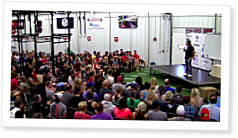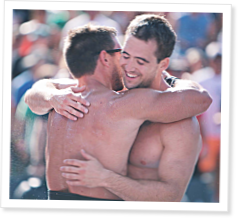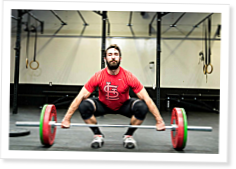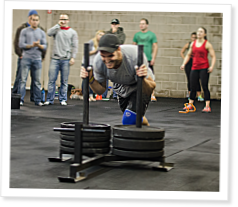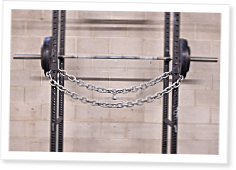by Steve Dussia
“What I have to share is a view of the man who probably influenced strength training more than anyone else of his generation. The success of those of you who followed his programs helped to cement his legend status.”
Read More
var addthis_config = {"data_track_addressbar":true};
In many of the tributes to Bill that I’ve read on the Internet, they are prefaced with “I never met the man, but…” I guess I never thought about it much, but I had the rare privilege, as it turns out, to know him well. Others certainly spent more time with him, and I’m sure that their memories would make for interesting reading. What I have to share is a view of the man who probably influenced strength training more than anyone else of his generation. The success of those of you who followed his programs helped to cement his legend status.When it came to training, and certainly when competing, Bill was strictly business. This was his legacy, as anyone who competed against him or was coached by him can attest. He was a fountain of knowledge, and his knack for being able to take a starting lifter to great heights, or squeeze the mental and physical maximum out of a top-level lifter, himself included, was well known.But Bill enjoyed being a normal human, occasionally, and sometimes found it hard to separate his life from his calling, as those who knew that their success in the lifting arena depended on him generally surrounded him. Training questions never received the response, “Get back to me on your next training day, and we’ll work it out then.” The wheels were always turning, helping his charges with advice on the physical and mental changes that would likely help.He understood that others enjoyed a brush with normalcy also, but rather than distract him from his focus, he incorporated the factors of normal life into The Strongest Shall Survive, and Defying Gravity. These included, but were not limited to, alcohol consumption, pharmaceutical and recreational drug use, sexual activity, and a myriad of other factors, some of which could be considered counterproductive to the doctrine he preached. He and I were in many ways an Odd Couple. I was by choice a non-drinker, while Bill was known to occasionally view life through the bottom of a beer bottle. Also, I had decided early in my lifting career that I would not be doing P.E.D.s, as they’re now called, while Bill admitted in his writings that he partook of these on occasion. It was in our similarities that we found our common ground, not the least of which was our inability to get wealthy. Enough money was, in many cases, not much more than enough. We ate tuna salads, cottage cheese, and as a special treat, we would go to the Kuhio Grill, a short walk from the athletic dorm, and have liver and onions. This was a special treat for me, as my liver intake normally was in the form of desiccated liver tablets, 200 per day to be exact. Even though our lives were both in orbit around the lifting platform, we found many other subjects to talk about.Bill was in the Air Force in the mid fifties, stationed in Iceland or Greenland, or one of those godforsaken places, so cold that the guy who discovered it was given a purple nurple as a reward. His first lifting activity was during this time, and he followed a basic routine given the available equipment, lots of small-hole weights and some homemade benches. But he loved to talk about Maryland, and fittingly, the life that began there in 1938, ended there in 2015. He wouldn’t have had it any other way. It seemed from talking to him, that all the places he had ever been were just stops on his way back to Maryland.His feelings for the place all came to fruition with the publication of his non-weightlifting novel, The Susquehanna River Hills Chronicles. If this book is available, order a copy and read a chapter a night. It will take awhile to finish it, even at that rate, and it is a part of Bill’s life that, even though set in the early 1800s, shows his devotion to his birthplace and his ability to step away, if only momentarily, from the “advice column” articles that we all know him for. If you’re concerned that you won’t reap any lifting benefits from reading it, at 700+ pages, you could always do some curls with it before putting it down. Bill and a friend of his from Maryland, during one of his leaves from the military, hopped on a motorcycle and made the pilgrimage to the York Barbell Club. Their timing must have been perfect, as they walked in on a training session with John Grimek, the only man to win the AAU Mr. America title twice, and Steve Stanko and a few other lifters handling poundages that must have seemed stupendous to these two novices. In that era, especially in York, bodybuilders did double duty as Olympic lifters, and both Grimek and Stanko were capable of doing overhead lifts well over three hundred pounds. Upon completion of the lifts, they would simply walk out from under the bar and let it crash to the platform. They had York t-shirts with the sleeves cut off, and were bulging with muscles in places where most guys didn’t even have places. Bill was as mesmerized as if the skies had opened, and angels with trumpets popped out. How could he know that within the next decade, he would be an integral part of the York organization, rubbing elbows with these very same men?He and his buddy were able to do a workout while there and the mystique of the place certainly played a part in their setting some new personal records. In a 2012 letter, he expressed his dismay that this building, the original York Barbell Building on Broad Street, had been torn down. He was under the impression that it was on the National Registry of Historical Places. I feel that this broke his heart, as he felt that part of his history was lost in the rubble also. This, combined with his attendance at the funeral of Smitty – the iconic Dick Smith, long time trainer of the York Barbell team – made him feel that the past was indeed slipping away. These two events effectively closed the book on Bill’s connection to York, which was to him and so many others the hub of the Olympic weightlifting world. He attended the event with Bill March, perhaps the greatest pure presser ever, and said that March was near 300 lbs and played golf 3-4x a week. If he didn’t realize it before, this brought home the fact that it was up to him to be sure that the memories of the Golden Era of Weightlifting, as he called it, didn’t just fade away.Over the years I came across numerous old Strength and Health magazines and always sent them to Bill. He loved reading the old articles, looking at the ads in the magazines and scanning the results sheets, and occasionally finding names of lifters he had worked with, or competed against. I ran across some as early as 1950, but there are older ones out there somewhere. Even a complete collection of these from day one would only skim the surface of the happenings at the time, and the impact of the collection of lifters whose names sometimes received mention only in these results. Even though more than a few lifters idolized Bill, he had his own set of idols. Certainly his encounter with Grimek and Stanko placed them on the list. But the one he mentioned a lot was Tommy Suggs. Bill, in his letters to me, used to mention a character known as “Sup,” which he explained to me later was an abbreviation for “Super Suggs.” I believe he actually competed against Suggs while in Texas, but when Tommy gave Bill the opportunity to join the York fraternity, he moved to the top of the list.Many great lifters gravitated to York during his tenure there, but few left a visual impression on Bill more than Norbert Schemansky. Norb was a split-style snatcher, certainly a point in his favor, and stayed at the top of the lifting game as long as anyone. Bill related a story to me about a meet, I believe in Virginia, where Norb was scheduled to lift. Bill and some of his buddies were at a bar close to the venue the night before the meet, and in walked Schemansky. Bill said it was like watching a prize bull walk out of the fog. They all agreed that this was what a lifter should look like. Bill, in the meantime, had fed all his spare change into the jukebox, and it was wall-to-wall Patsy Cline. When Schemansky remarked, “You can never get too much Patsy Cline,” Tommy’s reign at the top was threatened, to say the least.Following this meet, Bill was returning to York with Bob Bednarski, quite possibly the most dynamic lifter ever, who had defeated Schemansky at the contest. They stopped at a place called Natural Bridge, which was one of the 8 wonders of the world, and Bill said to him, “Maybe we should start calling you the 9th Wonder of the Weightlifting World.” The nickname stuck, and Barski was referred to by this nickname in print, as his star continued to rise. Having a marquee name on the York roster, which Bednarski became, certainly helped attract lifters from all over the country to the weekend workouts held in York, which were becoming as much a spectator sport as most lifting meets. These occurred with regularity at the York Barbell Club, and if you wanted to leave one of these sessions with bragging rights, you had best be approaching an American record.Bill’s ambition in helping put these sessions together did not go unnoticed by the management group at York. It was a classic case of ideas being invalid unless they were the ones to come up with them. Hoffman liked the idea, as the York team relied heavily on recruitment, but some of his underlings went out of their way to prevent Bill from currying too much favor within the organization. To Bill, it was all about the lifters; to the managers, it was all about the power and money. {pagebreak}Bill later worked for a time for the Weider organization as the editor of Muscle Builder magazine, which I’m sure didn’t sit well with the York crowd. Hoffman and Weider had been mortal enemies since the time they were across the river from each other, Weider having started in New Jersey.Probably one of the biggest differences between Bill and a gypsy was that Bill traveled more. Had he stayed in any one place permanently, his influence may not have been as great. His time spent in various areas and in numerous strength coaching positions exposed him to a very large and very diverse audience. These, in addition to his writings, made him one of the most recognizable personalities in the Iron Game.While in Hawaii, Bill’s visits to the lifting platform were as a powerlifter. There was a good core of lifters at the University, and many athletes, in the process of their lifting, were drafted for the “team.” And, as with everyplace else he settled, lifters and would-be lifters were drawn to the UH gym, knowing that good things would happen to their totals. Ray Verdonck, a 123 lb lifter who used to lift unopposed, and post token totals, started lifting there, followed me to Nautilus Fitness Center, and then Aiea Nautilus, eventually tying for second place in the World Powerlifting Championships at 132. He was one of the first lifters we trained to take full advantage of the more rigid belts, and the original “super suits.” He in turn helped Ed Morishima reach the World Championships in the 148 lb. class. Ray is now an international referee in several power organizations.John Phillip, whose story appeared in Defying Gravity, was Bill’s heavyweight protégé, and was involved in perhaps the weirdest event I ever witnessed in a lifting meet of any kind. While preparing for the World Championships, he entered a power meet at the Nuuanu YMCA. The bar used was an Olympic lifting bar, power bars being scarce in those days, and all weights used were 45s, 100-pounders not too common either. John was benching approximately 550, lowered the bar to his chest, got the signal, and blew it up like an empty bar. This was in a t-shirt, bench shirts not yet having been invented at that time. He was given 3 red lights and everyone was stunned. It may have ended there, but one of the judges felt that an explanation was required, and came into the warmup room to explain the red lights to John. In retrospect, this was a bad idea. John’s hand shot out and grabbed the ref, who shall remain nameless, by the neck, and lifted him off the ground with one hand. For some reason, and to the judge’s extreme relief, John let him go and he staggered back out the door. A few minutes later, Tommy Kono came into the warmup area and announced that the lift was now good. A three-red-light decision had become a three-green-light “good lift.” The reason given was that the bar was springy, and that the judges weren’t used to seeing this amount of weight bench-pressed. Bill had to admit that in his entire lifting career he had never seen a three-red-light decision reversed. It could have ended badly, as Gus Rethwisch, who at 6′5″ and 330 and no slouch himself in his “bouncing ability,” worked with John as a bouncer in the roughest bars in Hawaii, told me that he never saw anybody who could hit as hard as John. That may have explained why everyone just stood there in shock instead of jumping to the ref’s defense. Gus is the president of the WABDL, and could verify this story and many others about John.Bill had a unique project with John, because when they met John was a bench presser extraordinaire, and was able to do somewhere in the mid 500s for 10 very bouncy reps. Bill’s task was converting him to waiting for a signal before pressing, not to mention starting him training squats and deadlifts. Within a year and a half, John took 2nd in the World’s. John had previously been a world-class rugby player, and had killed a man in a match by spear tackling him, effectively ending John’s rugby career, and prompting the banning of spear tackling in that sport.Mike Lambert also trained at the UH at this time, and after he, Bill Nelson and myself published 4 issues of Powerlifting Hawaii, Mike took the concept to Camarillo California, where it became Powerlifting USA, enjoying a 30+ year run, as THE source of powerlifting news. Bill was a big fan of high rep squats, generally 20 reps, and believed that no form of aerobics could raise your heart rate to such a level in the same amount of time. O.K., maybe running up a sand dune with a sumo wrestler on your back for 5 minutes without stopping. When you first start, you feel that maybe 10 reps would be reasonable. But with Bill berating you, you found the ability to do 11, then 12, then… Not among my fondest memories, but it does show the power of the mind, and your ability to tap into it. God forbid you did 18, and then put the bar back on the rack. Bill would recommend that you have a sex change operation, and come back when you were a man.I mentioned in my first part that we did heavy weighted dips. These had the valuable side effect of decompressing the spine, as you can imagine, with a leather belt across your hips, and over 200 lbs pulling down. Sometimes when you’re Defying Gravity on a regular basis, it helps to let gravity stretch things back out. We also used the upper position to increase our shrugging range by shifting the head forward at the top and allowing the shoulders to move up above our ears. Start this with no weight resistance; your bodyweight may be enough. When we did shrugs, we would start with a wide snatch grip, which allowed more shoulder elevation with a lighter weight. As the weight increased the grip was narrowed as the ability to elevate the bar was limited by the poundage. We always used an overhand grip and hook gripped until this was no longer feasible, and then used straps. Shrugs normally were done immediately after high pulls when they became less high. Lest you think that all was fun and games, Bill, at this time was marketing SSS, staying in touch, by letters naturally, with many of his friends/trainees, creating and upgrading programs for at least 50 athletes in different sports, supervising the athletic dorm, working at bars at night, and getting his own workouts in his “spare time.” He also learned from virtually everyone he coached. Some probably picture him in a lifeguard stand, raining training programs down on the mass of lifters below. If you trained under him, he observed and learned from your results. He felt that everyone had things that they did as well, or better than almost anyone else. They may not have produced the desired results due to lack of potential or failing to apply the other aspects of their training, but they contributed something. I likened it to the days when bodybuilding contests gave subdivision awards. Guys would show up with unreal arms, massive chests, or definition like a skinned squirrel… not to win, but to take home a trophy. It had the effect of showing those with winning in mind, what the possibilities were, and to learn how to blend these things into a balanced physique. Bill took this concept to the strength fraternity, and by the process of elimination, came up with programs that were the most productive with the least experimentation by the participant. Instead of being one big thing, it was the sum of the parts.Many stories involving Bill could start with the phrase, “one night while working at the club…” This long one starts with: One night, actually Halloween night, after the club closed down, we were heading back to the dorm, five of us packed into Bill’s Karmann Ghia, riding through Kahala, a very upscale neighborhood in Honolulu, when an egg flew through the car right in front of the passengers and Bill’s face. Bill said, “We’re going back,” drove a block or two and turned around, went back and whipped into the driveway where the egg came from. There stands a guy with a row of eggs across his forearm, and one in his hand. To say that things went rapidly downhill for him at that point would be an understatement. To make a short story long, I power cleaned him, gripping him by his pecs, man boobs, whatever, and stuffed him into a hedge where he couldn’t get out. Big Peter, Bill’s passenger, took advantage of his predicament by applying a few well-placed jabs to the nose, and then we all crammed back into the car. Bill was commenting on how much he liked my cleaning technique, when the door to the house burst open, and guys came running out and bashed all the windows out of Bill’s car with trashcans. We immediately exited the car, and at this point these guys probably thought the story would end there. They were wrong. We followed them into the house where dozens of egg flats were stacked on the counter. In less time than it takes to read this, the eggs were strewn throughout the house (I told you this was a long story). Before we could get our car out of the driveway, the cops showed up. Bill knew some of them, and I knew the others, which certainly worked in our favor. They recommended that Bill have his windows replaced at his earliest convenience, and sent us on our way. As the cost to replace the windows would have exceeded the value of the car, we used it for short-range transportation for a while, and then abandoned it. The End.Actually just the end of that story. Next one involves cleans, but no eggs. Actually hang cleans, an exercise to develop the top pull, and one of my favorite exercises of all time. You deadlift the weight, ease it down to just above knee level with a flat back, and violently pull it up to your shoulders. The weight was up to 350 and I was primed to do a double, Bill was off to my left watching my line of pull. As I was ready to start the 1st clean, Don “Hulk” Herrold and Gary “Thor” Spotts began kickboxing each other right in front of me. I squat-cleaned the weight, stood up and repositioned and did a second rep, all the while with a fight taking place within a foot or two of my face. When I was finished, Bill said that he had never seen such an example of extreme concentration in his life. That comment meant more to me than my entire collection of trophies.Maybe that sums it up. Bill could supply you with the formula; he could want you to perform up to your potential, but having him in your corner when the bar was loaded was the intangible that he brought, that I wish everyone could have experienced at least once.I hope these stories show that Bill was not just some weightlifting guru, dispensing training info like a vending machine. When the lights went out in the weight room at the end of the day, he became as normal as you or me. What’s that you say – you’re not totally normal? Well, neither was Bill, and he liked it that way.









